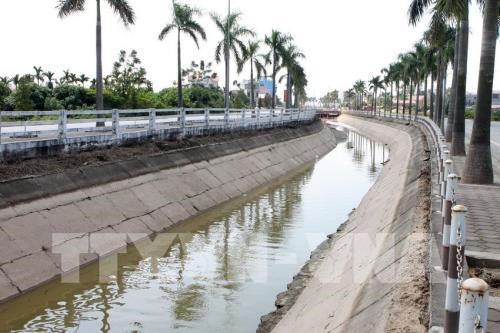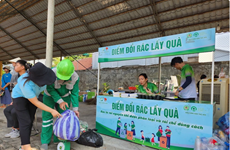Hanoi exerts efforts to tackle environmental pollution
Hanoi’s environmental problems have been basically solved since the city made its administrative boundary adjustment in 2008.
 A canal in the capital city of Hanoi. (Photo: VNA)
A canal in the capital city of Hanoi. (Photo: VNA)Hanoi (VNA) – Hanoi’s environmental problems have been basically solved since the city made its administrative boundary adjustment in 2008.
After the resolution of the National Assembly on the adjustment of Hanoi’s administrative boundaries ten years ago, the total area of natural land of the capital is nearly 335,000 hectares.
As the largest ever city in the country, Hanoi faced enormous challenges in dealing with environmental pollution and ensuring a safe and healthy life for nearly 6.3 million citizens.
Statistics showed that after 2008, Hanoi had 266 out of 1,350 villages causing serious environmental pollution with about 60,000 cu.m of wastewater discharged directly into the environment every day.
Total daily discharge was over 300,000 cu.m, with one third of which being industrial wastewater.
Most of industrial production establishments directly released wastewater into major rivers, making the majority of rivers and lakes in Hanoi polluted.
With a high determination alongside comprehensive and scientific measures, the municipal authorities have effectively implemented the Prime Minister’s Decision on approving the plan to thoroughly handle establishments that seriously pollute the environment, considering this the top priority in preserving the capital’s environment.
The municipal Department of Natural Resources and Environment has coordinated with relevant departments and sectors in advising the city People's Committee to thoroughly deal with all the 25 seriously polluting establishments.
The department has also advised the municipal authorities to relocate industrial production establishments with high risks to suburban areas to prevent pollution sources.
Director of the department Nguyen Trong Dong said the city paid special attention to improving the environment in To Lich and Nhue rivers, with many projects and programmes that focused on dredging the rivers’ bed.
Up to now, the city has built and put into operation urban wastewater treatment stations and plants in an effective manner, ensuring wastewater after treatment meets environmental standards. They raised the total wastewater treatment capacity to 261,300 cu.m a day, or 32 percent of total wastewater that needs treatment.
In addition, in 43 operating industrial clusters, 21 wastewater treatment stations have been completed and put into stable operation.
According to Hanoi’s Department of Construction, the rate of daily waste collection reached 98 percent in inner-city districts, and 87 percent in suburban districts.
Notably, as many as 12 solid waste treatment areas has been constructed, while two large-scale waste treatment areas in Soc Son and Ba Vi districts have been upgraded.
Experts, however, said that in the long run, Hanoi needs more comprehensive and comprehensive measures to promote sustainable development.
Attention should be paid to building environmental monitoring systems and devising policies to accelerate the progress of technical infrastructure projects for protecting the environment, and handing environmental pollution in industrial parks and trade villages, they stressed.-VNA













